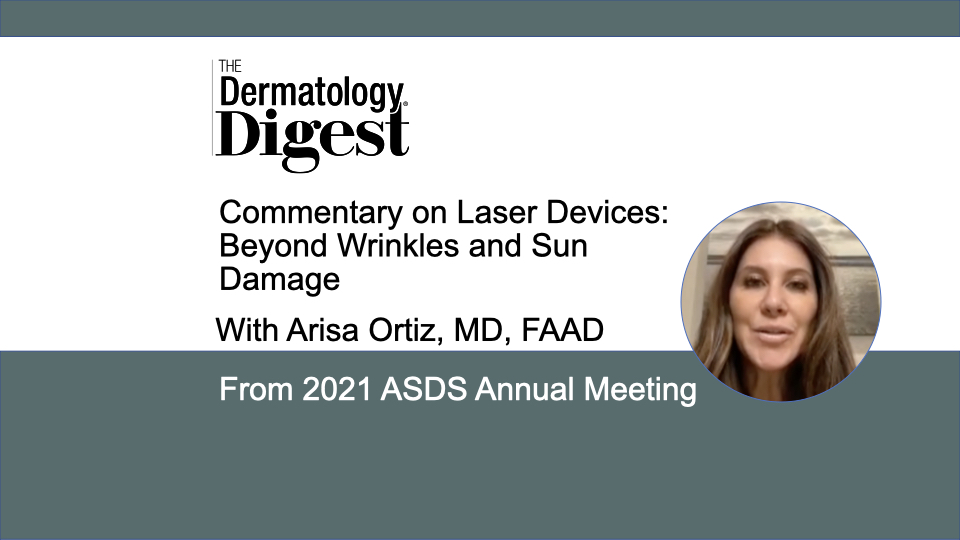Dr. Arisa Ortiz discusses laser treatment with the 1064 nm Nd:YAG for medical indications that affect the skin.
Arisa Ortiz, MD, FAAD, is Director of Laser and Cosmetic Dermatology and Associate Clinical Professor in the Department of Dermatology at UC San Diego.
“There are so many medical indications that we use [lasers] for and so my focus was the 1064 nm Nd:YAG laser,” said Arisa Ortiz, MD, FAAD, a presenter in the session “Already Have a Laser Device? Think Beyond Wrinkles and Sun Damage” at the 2021 American Society for Dermatologic Surgery (ASDS) Annual Meeting.Each presenter in the session focused on a specific modality.
Port Wine Stains
“One of the things that I use it for is thicker port wine stains—port wine stain birthmarks.”
Superficial wavelengths are not effective for treating port wine stains that have vascular blebs or have developed deeper vessels over time, said Dr. Ortiz.
“I commonly will use a combination of the 1064 nm Nd:YAG laser to get the deeper component, like the blebs or the thicker port wine stain portions, and then I’ll combine that with more superficial wavelengths like the pulsed dye laser or KTP laser.
Because the 1064 nm Nd:YAG laser absorbs oxyhemoglobin, this laser isn’t for the inexperienced dermatologist, cautioned Dr. Ortiz.
“…there might be arterial absorption. It’s not a beginner laser in that sense because it may cause ulceration and so you have to be very careful. I space the pulses far apart so that there’s no ulceration or scarring.”
BCC
As a Mohs surgeon, Dr. Ortiz said she focuses much of her research on finding safe and efficacious noninvasive treatments for skin cancer. She published a recent study showing a 90% histologic clearance rate of basal cell carcinoma (BCC) after a single treatment with the 1064 nm Nd:YAG laser.1
“I focus mostly on non-Mohs criteria tumors, so off of the face, non-aggressive subtypes, but it’s just a single treatment. It’s coded under a destruction code, so it’s covered by insurance. It’s just for patients that are poor surgical candidates or those that are surgically exhausted. It’s a nice alternative for them—another modality that we have in our armamentarium.”
However, Dr. Ortiz said she does sometimes make exceptions for treating tumors on the face in older patients with multiple tumors.
In another (unpublished) study, Dr. Ortiz found only 1 of 34 tumors recurred after a single treatment with the 1064 nm Nd:YAG laser.
“I think that we have a lot of good data now showing that it’s a good alternative and clearances are even better than [with] some of the topicals that we use.”2
Acne
The 1064 nm Nd:YAG also has a role for acne patients interested in or need alternative treatments, whether they are concerned about their microbiome health, antibiotic averse, or not responding to traditional treatments, said Dr. Ortiz.
“I still think medical therapy is the first line but for those patients who either aren’t responding or don’t want to take antibiotics, then I really like using the of 1064 nm Nd:YAG specifically with the 650 microsecond pulse.”
According to Dr. Ortiz, the 1064 nm Nd:YAG acne treatment protocol for is a total of 4 treatments, every 1 to 2 weeks. Patients experience no pain or downtime, she said.
“It’s a great alternative treatment for acne.”
Pseudofolliculitis Barbae
Because the 1064 nm Nd:YAG has a longer wavelength, it bypasses epidermal melanin making it safe for all skin types, including types 5 and 6, said Dr. Ortiz.
“There’s a condition called pseudofolliculitis barbae where [darker skin types] get inflammation of the follicles, and you can treat that with hair removal.”
Medical vs. Cosmetic
Despite growing evidence that supports the medical use of laser devices, such as the 1064 nm Nd:YAG, in Dr. Ortiz’s experience, insurance generally only covers skin cancer (when using a destruction code) and port wine stains.
“I think it brings attention to the fact that we need to work on getting more insurance coverage for these medical treatments. Even though we’re using lasers, it’s not [for] a cosmetic indication.”
References:
- Ortiz AE, Anderson RR, DiGiorgio C, Jiang SIB, Shafiq F, Avram MM. An expanded study of long-pulsed 1064 nm Nd:YAG laser treatment of basal cell carcinoma. Lasers Surg Med. 2018 Feb 13. doi: 10.1002/lsm.22803. Epub ahead of print. PMID: 29436720.
- Ahluwalia J, Avram MM, Ortiz AE. The Evolving Story of Laser Therapeutics for Basal Cell Carcinoma. Dermatol Surg. 2020 Aug;46(8):1045-1053. doi: 10.1097/DSS.0000000000002339. PMID: 32049702.


